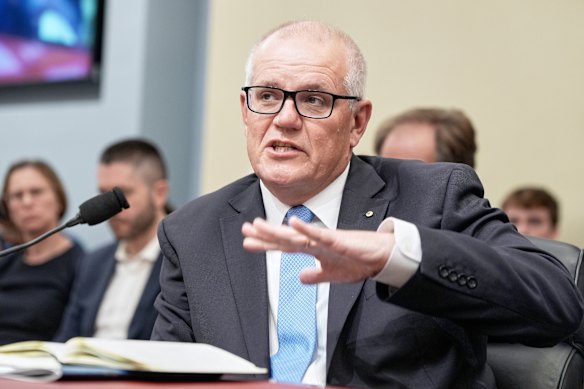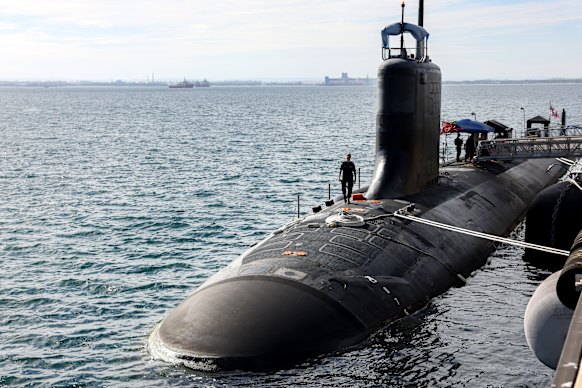By Holly Thompson and Cameron Myles
Former prime minister Scott Morrison thinks a joint US-Australia naval base at an industrial precinct south of Perth could help the Trump administration overcome “legitimate issues” to get the AUKUS deal over the line.
Speaking after appearing before a congressional committee in Washington, Morrison proposed turning the planned Henderson shipbuilding facility into a joint base, which would allow both American and Australian submarines to be hosted and repaired there, and give the US direct access to the Indian Ocean.

Scott Morrison testifies during a House Select Committee on China on Wednesday, US time.Credit: AP
The US is reviewing the AUKUS deal, and the chosen scrutineer – Elbridge Colby – appears poised to recommend a raft of changes.
Would a joint naval base in Perth’s south appease the current US administration? And does the idea even make sense?
What’s happening in Henderson?
What is now a busy shipbuilding and industrial precinct has a long naval history, evidenced by the name of the neighbouring suburb to the south: Naval Base.
There were plans for a base named after British Admiral Reginald Henderson afoot in the early 20th century, but the outbreak of World War I and technical hurdles including trouble dredging Cockburn Sound saw the project scuppered in 1920.
Work began on what eventually became the HMAS Stirling naval base on Garden Island, across the sound, in the 1960s.
The Australian Marine Complex in Henderson took shape in the early 2000s and houses shipbuilding and fabrication infrastructure among its five precincts.
It is here the government plans to grow a new defence precinct to maintain nuclear-powered submarines under the AUKUS deal, and has committed $127 million over three years to do so. That’s on top of $8 billion in upgrades to HMAS Stirling through to the mid-2030s.
Immediately south of Henderson is the Kwinana Industrial Area, home to major operations run by Alcoa, Tianqi Lithium and BP, among others.
The KIA will also be the future home of a massive container terminal when the WA state government’s plans to shift the port from its current location at the Fremantle inner harbour come to fruition.
How would the locals react to a US Navy presence?
Already there has been disquiet in the port city of Fremantle to the north over the presence of nuclear-powered submarines at Henderson and HMAS Stirling under the AUKUS agreement.
The federal MP whose electorate encompasses Henderson – Labor’s Josh Wilson – has previously broken ranks to oppose the agreement, saying in 2023 he did not believe the deal was in Australia’s national interest.
The City of Fremantle – the local government above the City of Cockburn, which encompasses Henderson – has also been petitioned by locals to push back on the AUKUS plans under its nuclear-free policy and pledge.
Fremantle was the first local government in WA to declare itself a nuclear-free zone more than four decades ago.
What is the likelihood of a joint base in Henderson?
Defence expert Jennifer Parker, an adjunct fellow at the Australian National University, believes the proposal doesn’t make sense, and could add unnecessary complexity to existing plans for Henderson.
“Henderson really is focused on becoming a defence precinct that can support Australia’s sovereign shipbuilding,” Parker said.
“Now a component of Henderson … will conduct depot-level maintenance for submarines, and it will include US submarines, and that’s part of the benefit to the US in this deal.
“But to do that, it doesn’t need to be a joint base whatsoever.
“In fact, really, that would put probably unnecessary tension on delivering what we need to deliver in Henderson, which is turning it into a defence precinct that has the ability to build large ships and maintain submarines for Australia.”
Parker said US submarines and personnel would be already stationed at the nearby HMAS Stirling on Garden Island under the current AUKUS plans.

Virginia-class fast attack submarine USS Minnesota docked at HMAS Stirling in February.Credit: Getty Images
“Changing the structure of the base, how it’s named, how it’s administrated, adds no operational capability whatsoever to either shipbuilding and submarine maintenance or support to the squadron in WA,” she said.
“But what it does do is denude some of Australia’s control over its main bases, and at Henderson, it could get in the way of Australia’s priority, which is shipbuilding.”
The proposal also has the backing of former home affairs secretary Mike Pezzullo, who likened a joint US-Australia Henderson base to the Pine Gap intelligence facility in the Northern Territory.
Whether the logistics line up is another story.